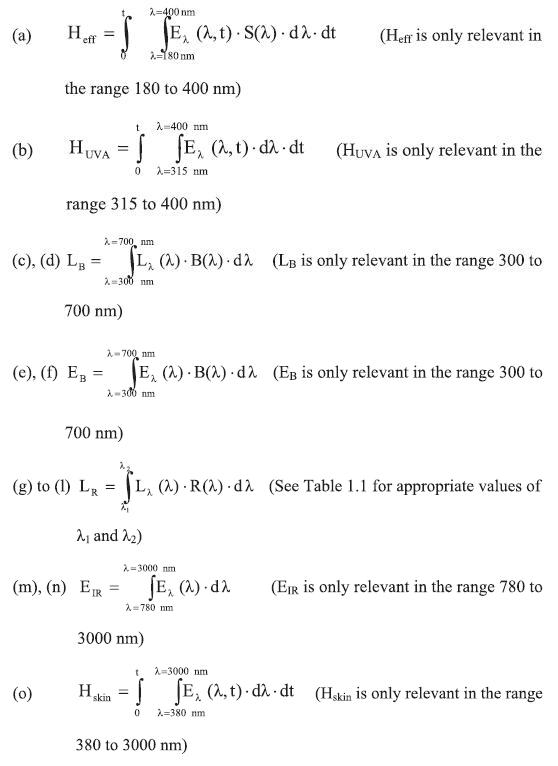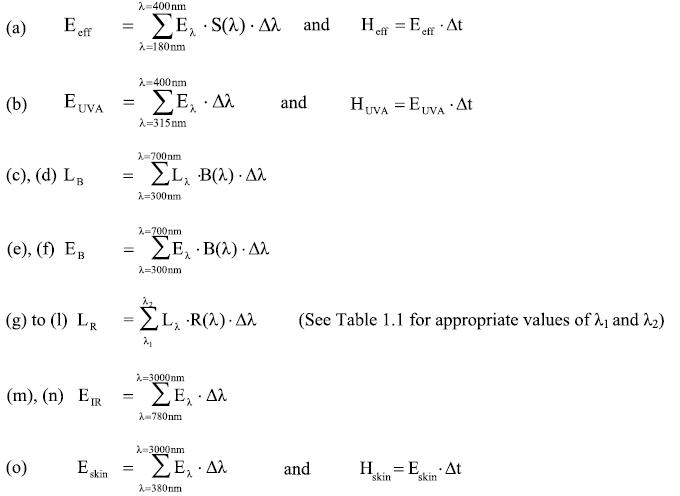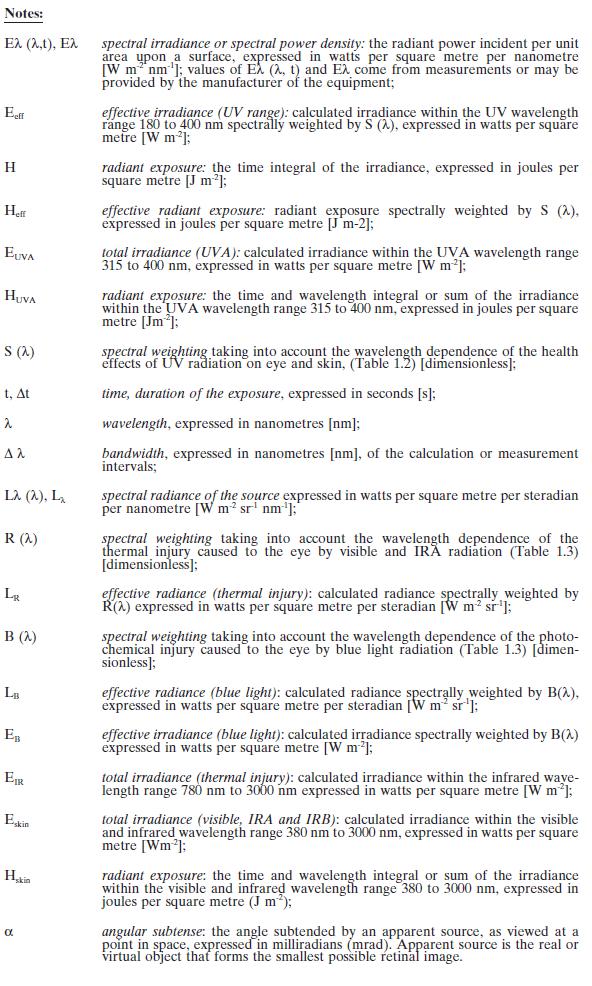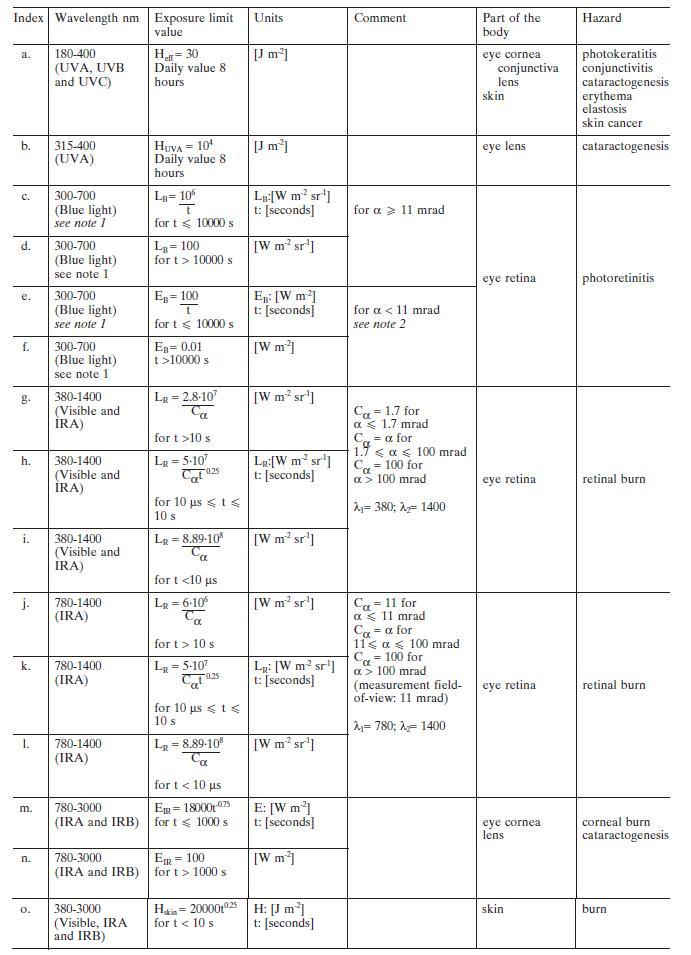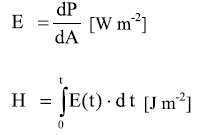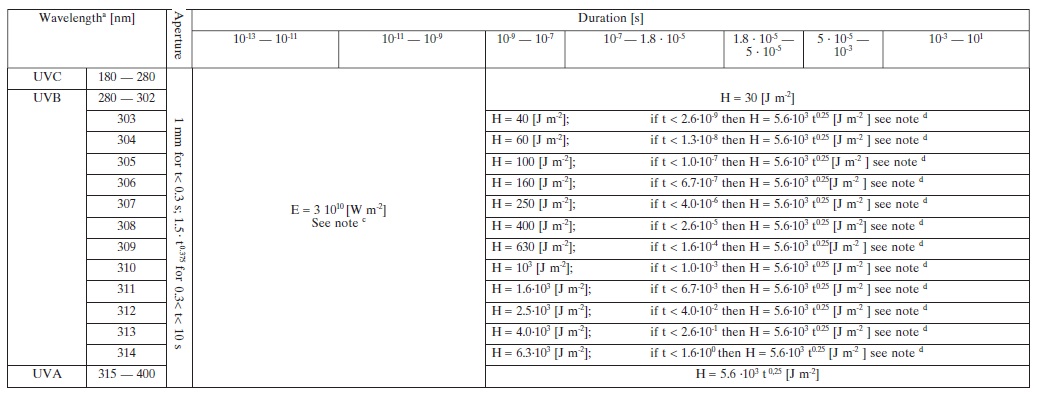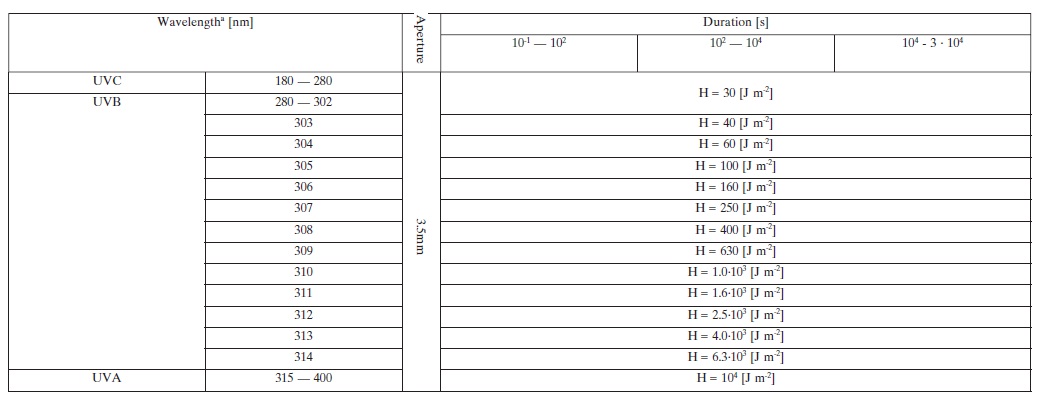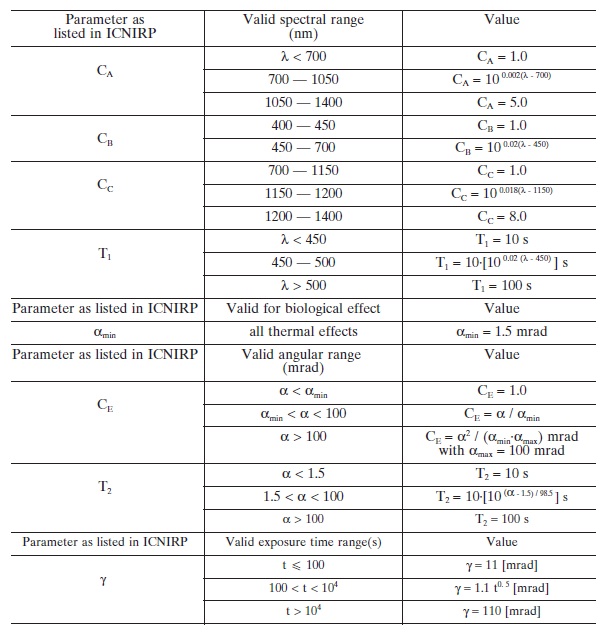S.I. No. 176/2010 - Safety, Health and Welfare at Work (General Application) (Amendment) Regulations 2010.
Notice of the making of this Statutory Instrument was published in | ||
“Iris Oifigiúil” of 4th May, 2010. | ||
I, BATT O’KEEFFE, Minister for Enterprise, Trade and Employment, in exercise of the powers conferred on me by section 58 of the Safety, Health and Welfare at Work Act 2005 (No. 10 of 2005), for the purpose of giving effect to Directive 2006/25/EC of the European Parliament and the Council of 5 April 2006 1 , on the minimum health and safety requirements regarding the exposure of workers to risks arising from physical agents (artificial optical radiation) and after consultation with the Health and Safety Authority, hereby make the following regulations: | ||
1. (1) These Regulations may be cited as the Safety, Health and Welfare at Work (General Application) (Amendment) Regulations 2010. | ||
(2) In these Regulations “Principal Regulations” means the Safety, Health and Welfare at Work (General Application) Regulations 2007 ( S.I. No. 299 of 2007 ) as amended by the Safety, Health and Welfare at Work (General Application) (Amendment) Regulations 2007 ( S.I. No. 732 of 2007 ). | ||
(3) The Principal Regulations and these Regulations may be cited together as the Safety, Health and Welfare at Work (General Application) Regulations 2007 to 2010. | ||
2. The Principal Regulations are amended— | ||
(a) by inserting in the “Arrangement of Regulations”, after “PART 8, EXPLOSIVE ATMOSPHERES AT PLACES OF WORK”, the following: | ||
“PART 9 Control of Artificial Optical Radiation at Work | ||
176. Interpretation for Part 9. | ||
177. Application of Part 9. | ||
178. Exposure Limit Values. | ||
179. Determination of Exposure and Assessment of Risks. | ||
180. Provisions aimed at Avoiding or Reducing Exposure. | ||
181. Employee Information and Training. | ||
182. Health Surveillance.”, | ||
(b) by inserting in the “Arrangement of Regulations”, after “Schedule 10, EXPLOSIVE ATMOSPHERES”, the following: | ||
“SCHEDULE 11 ARTIFICIAL OPTICAL RADIATION | ||
Part 1: Non-Coherent Optical Radiation | ||
Part 2: Laser Optical Radiation | ||
Part 3: Assessment, Measurement and Calculation of Exposure”, | ||
(c) by inserting, after “PART 8, Regulation 175”, the following: | ||
“PART 9 Control of Artificial Optical Radiation at Work | ||
Interpretation for Part 9. | ||
176. (1) In this Part— | ||
“Directive” means Directive 2006/25/EC of the European Parliament and of the Council of 5 April 2006 2 ; | ||
“exposure limit value” means the limits on exposure to optical radiation which are based directly on established health effects and biological considerations. Compliance with these limits will ensure that workers exposed to artificial sources of optical radiation are protected against all known adverse health effects; | ||
“irradiance (E) or power density” means the radiant power incident per unit area upon a surface expressed in watts per square metre (W m-2); | ||
“laser (light amplification by stimulated emission of radiation)” means any device which can be made to produce or amplify electromagnetic radiation in the optical radiation wavelength range primarily by the process of controlled stimulated emission; | ||
“laser radiation” means optical radiation from a laser; | ||
“level” means the combination of irradiance, radiant exposure and radiance to which an employee is exposed; | ||
“non-coherent radiation” means any optical radiation other than laser radiation; | ||
“optical radiation” means any electromagnetic radiation in the wavelength range between 100 nm and 1 mm. The spectrum of optical radiation is divided into ultraviolet radiation, visible radiation and infrared radiation: | ||
(a) ultraviolet radiation: optical radiation of wavelength range between 100 nm and 400nm. The ultraviolet region is divided into UVA (315-400 nm), UVB (280315 nm) and UVC (100-280 nm); | ||
(b) visible radiation: optical radiation of wavelength range between 380 nm and 780 nm; | ||
(c) infrared radiation: optical radiation of wavelength range between 780 nm and 1mm. The infrared region is divided into IRA (780-1400 nm), IRB (1400-3000nm) and IRC (3000 nm-1 mm); | ||
“radiance (L)” means the radiant flux or power output per unit solid angle per unit area, expressed in watts per square metre per steradian (W m-2 sr-1); | ||
“radiant exposure (H)” means the time integral of the irradiance, expressed in joules per square metre (J m-2). | ||
(2) A word or expression that is used in this Part and is also used in the Directive has, unless the contrary intention appears, the same meaning in this Part as in the Directive. | ||
Application of Part 9. | ||
177. This Part shall apply to activities in which employees are, or are likely to be, exposed to risks to their safety and health arising from exposure to artificial optical radiation during their work and, in particular, the risk to the eyes and to the skin. | ||
Exposure Limit Values. | ||
178. (1) The exposure limit values for non-coherent radiation, other than that emitted by natural sources of optical radiation, are as set out in Part 1 of Schedule 11. | ||
(2) The exposure limit values for laser radiation are as set out in Part 2 of Schedule 11. | ||
Determination of Exposure and Assessment of Risks. | ||
179. (1) Without prejudice to the requirements of sections 19 and 20 of the Act, where employees are exposed to artificial sources of optical radiation, an employer shall, in consultation with his or her employees or their representatives, or both, make a suitable and appropriate assessment of the risk arising from such exposure. | ||
(2) In carrying out the assessment referred to in paragraph (1), an employer shall, if necessary, measure and or calculate the level of exposure to artificial optical radiation to which his or her employees are exposed. | ||
(3) The level of exposure to artificial optical radiation shall be assessed, measured or calculated on the basis set out in Part 3 of Schedule 11. | ||
(4) An employer shall be responsible for the assessment referred to in paragraph (1) being planned and competently carried out at suitable intervals. | ||
(5) An employer shall give particular attention when carrying out the assessment referred to in paragraph (1) to the following— | ||
(a) the level, wavelength range and duration of exposure to artificial sources of optical radiation, | ||
(b) the exposure limit values specified in Regulation 178 and Schedule 11, | ||
(c) the effects of exposure to artificial sources of optical radiation on employees whose safety or health is at particular risk from such exposure, | ||
(d) any possible effects on employee safety or health resulting from workplace interactions between artificial optical radiation and photosensitising chemical substances, | ||
(e) any indirect effects such as temporary blinding, explosion or fire, | ||
(f) the existence of replacement equipment designed to reduce the levels of exposure to artificial optical radiation, | ||
(g) appropriate information obtained from health surveillance, including published information, as far as possible, | ||
(h) multiple sources of exposure to artificial optical radiation, | ||
(i) a classification applied to a laser as defined in accordance with the relevant IEC standard and, in relation to any artificial source likely to cause damage similar to that of a laser of class 3B or 4, any similar classification, | ||
(j) information provided by the manufacturers of artificial optical radiation sources and associated work equipment in accordance with the relevant Community Directives. | ||
(6) An employer shall record in the safety statement prepared pursuant to section 20 of the Act— | ||
(a) the findings of the assessment referred to in paragraph (1) as soon as possible after it is made, and | ||
(b) the steps which he or she has taken to meet the requirements of Regulations 180 to 182. | ||
(7) The assessment referred to in paragraph (1) and, if necessary, either or both the measurement and calculation referred to in paragraph (2) shall be reviewed at suitable intervals and, in particular, where either of the conditions specified in section 19(3)(a) or (b) of the Act are met. | ||
Provisions aimed at Avoiding or Reducing Exposure. | ||
180. (1) Having regard to the general principles of prevention in Schedule 3 to the Act, and in consultation with his or her employees or representatives, or both, an employer shall ensure, so far as is reasonably practicable, that risk from the exposure of his or her employees to artificial optical radiation is either eliminated at source or reduced to a minimum. | ||
(2) Where the risk assessment carried out under Regulation 179 for employees exposed to artificial sources of optical radiation indicates any possibility that the exposure limit values may be exceeded, an employer shall devise and implement an action plan comprising either or both the technical and organisational measures designed to prevent the exposure exceeding the limit value, taking into account in particular: | ||
(a) other methods of work which reduce the risk from exposure to artificial optical radiation, | ||
(b) the choice of work equipment which, taking account of the work to be done, emits less artificial optical radiation including the possibility of making available to employees work equipment in compliance with section 16 of the Act with the aim or effect of limiting exposure to artificial optical radiation, | ||
(c) technical means to reduce the emission of artificial optical radiation including, where necessary, the use of inter-locks, shielding or similar health protection mechanisms, | ||
(d) appropriate maintenance programmes for work equipment, the places of work, workstations and systems of work, | ||
(e) the design and layout of places of work and workstations, | ||
(f) limitation of the duration and level of exposure to artificial optical radiation, | ||
(g) provision of appropriate personal protective equipment, and | ||
(h) the instructions of the manufacturer of the equipment where it is covered by relevant Community Directives. | ||
(3) Where a risk assessment carried out pursuant to Regulation 179 indicates that there are workstations within the place of work where employees are likely to be exposed to artificial optical radiation above the exposure limit values, an employer shall— | ||
(a) display mandatory signs, in accordance with Chapter 1 of Part 7, which convey that the artificial optical radiation level is likely to exceed that exposure limit value, and | ||
(b) ensure that such workstations are identified and are protected from unauthorised access, by barriers or other suitable measures where such measures are technically feasible and where there is a risk that the exposure limit values could be exceeded. | ||
(4) An employer shall ensure that his or her employees are not exposed to artificial optical radiation above the exposure limit values. | ||
(5) Where, despite the measures taken to comply with this Part, exposure limit values are exceeded the employer shall— | ||
(a) take immediate action to reduce exposure to artificial optical radiation to below the exposure limit values, | ||
(b) as soon as practicable, identify the reasons for the exposure limit values being exceeded, and, | ||
(c) amend either or both the technical and organisational measures taken in accordance with paragraph (2) to prevent the exposure limit values being exceeded again. | ||
(6) Without prejudice to the provisions of section 10(1)(d) of the Act, an employer shall adapt any measures taken in compliance with the requirements of this Regulation to take account of any employee whose safety or health is at particular risk from exposure to artificial optical radiation. | ||
Employee Information and Training. | ||
181. (1) Without prejudice to sections 9 and 10 of the Act, an employer shall, where his or her employees are exposed to risk from artificial optical radiation, provide them or their representatives, or both, with suitable and sufficient information and training relating to the outcome of the risk assessment made pursuant to Regulation 179. | ||
(2) Without prejudice to the generality of paragraph (1), the information and training provided under this Regulation shall include— | ||
(a) the technical and organisational measures taken in order to comply with this Part, | ||
(b) the exposure limit values and associated potential risks, | ||
(c) the results of the risk assessment and either or both the measurement and calculation of the levels of exposure to artificial optical radiation carried out in accordance with Regulation 179 and an explanation of their significance and potential risks, | ||
(d) how to detect and report signs of adverse health effects, | ||
(e) the circumstances in which health surveillance is made available to employees and its purpose, in accordance with Regulation 182, | ||
(f) safe working practices to minimise risks from exposure to artificial optical radiation, and | ||
(g) proper use of appropriate personal protective equipment. | ||
(3) Consultation of employees pursuant to Regulations 179(1) and 180(1) shall be effected in accordance with section 26 of the Act. | ||
Health Surveillance. | ||
182. (1) Without prejudice to section 22 of the Act, it shall be the duty of an employer to ensure that appropriate health surveillance is made available to those employees for whom a risk assessment referred to in Regulation 179 reveals a risk to their health, including employees exposed to artificial optical radiation in excess of an exposure limit value. | ||
(2) Health surveillance, the results of which are taken into account in the application of preventive measures at a particular place of work, shall be intended to prevent or diagnose rapidly any long-term health risks and any risk of chronic disease resulting from exposure to artificial optical radiation. | ||
(3) An employer shall ensure that a health record in respect of each of his or her employees who undergoes health surveillance is made and maintained and that that record or a copy thereof is kept available in a suitable form so as to permit appropriate access at a later date, taking into account any confidentiality concerns. | ||
(4) An employer shall— | ||
(a) on request, allow an employee access to his or her personal health record, | ||
(b) provide the Authority with copies of such health records as the Authority may require, | ||
(c) provide the registered medical practitioner, under whose responsibility an employee receives health surveillance, with the results of the risk assessment referred to in Regulation 179 where such results may be relevant to the health surveillance, and | ||
(d) if he or she ceases to trade, notify the Authority forthwith in writing and make available to the Authority all health records kept by him or her in accordance with this Part. | ||
(5) Without prejudice to the generality of paragraph (1), an employer shall in the case of an employee whose exposure exceeds the limit values, or where as a result of health surveillance an employee is found to have an identifiable illness or adverse health effect which, in the opinion of a registered medical practitioner, is the result of exposure at work to artificial optical radiation, make available to them the services of a registered medical practitioner to carry out, or to have carried out on his or her responsibility a medical examination. | ||
(6) Without prejudice to the generality of paragraph (1), when an employee’s exposure to artificial optical radiation exceeds the exposure limit values, or where as a result of health surveillance an employee is found to have an identifiable illness or adverse health effect which, in the opinion of a registered medical practitioner, is the result of exposure at work to artificial optical radiation— | ||
(a) the registered medical practitioner shall inform the employee of the result which relates to him or her personally, including information and advice regarding such health surveillance which he or she should undergo following the end of the exposure, | ||
(b) the registered medical practitioner shall inform the employer of any significant findings of the health surveillance, taking into account any medical confidentiality, | ||
(c) the employer shall: | ||
(i) review the risk assessment made under Regulation 179, | ||
(ii) review the measures provided to eliminate or reduce the risk under Regulation 180, | ||
(iii) take account of the advice of the registered medical practitioner or a relevant competent person, or the Authority, in implementing any measures required to eliminate or reduce risk in accordance with Regulation 180, | ||
(iv) arrange continued health surveillance and provide for a review of the health status of any employee who has been similarly exposed, and | ||
(v) take account of the recommendations of the registered medical practitioner or a relevant competent person regarding further medical examination.”, and | ||
(d) by inserting the following after Schedule 10: | ||
“Regulations 178 and 179 | ||
SCHEDULE 11 ARTIFICIAL OPTICAL RADIATION | ||
Part 1 Non-Coherent Optical Radiation | ||
The biophysically relevant exposure values to optical radiation can be determined with the formulae below. The formulae to be used depend on the range of radiation emitted by the source and the results should be compared with the corresponding exposure limit values indicated in Table 1.1. More than one exposure value and corresponding exposure limit can be relevant for a given source of optical radiation. | ||
Numbering (a) to (o) refers to corresponding rows of Table 1.1. | ||
| ||
| ||
For the purposes of these Regulations, the formulae above can be replaced by the following expressions and the use of discrete values as set out in the following tables: | ||
| ||
| ||
| ||
| ||
Table 1.1: Exposure limit values for non-coherent optical radiation | ||
| ||
| ||
Note 1: The range of 300 to 700 nm covers parts of UVB, all UVA and most of visible radiation; however, the associated hazard is commonly referred to as blue light hazard. Blue light strictly speaking covers only the range of approximately 400 to 490 nm. | ||
Note 2: For steady fixation of very small sources with an angular subtense < 11 mrad, LB can be converted to EB. This normally applies only for ophthalmic instruments or a stabilised eye during anaesthesia. The maximum “stare time” is found by:tmax = 100 / EB with EB expressed in W m-2. Due to eye movements during normal visual tasks this does not exceed 100 s. | ||
Table 1.2: S (λ) [dimensionless], 180 nm to 400 nm | ||
| ||
Table 1.3: B (λ), R (λ) [dimensionless], 380 nm to 1400 nm | ||
| ||
Part 2 Laser Optical Radiation | ||
The biophysically relevant exposure values to optical radiation can be determined with the formulae below. The formulae to be used depend on the wavelength and duration of radiation emitted by the source and the results should be compared with the corresponding exposure limit values indicated in the Tables 2.2 to 2.4. More than one exposure value and corresponding exposure limit can be relevant for a given source of laser optical radiation. | ||
Coefficients used as calculation tools within the Tables 2.2 to 2.4 are listed in Table 2.5 and corrections for repetitive exposure are listed in Table 2.6. | ||
| ||
| ||
| ||
Table 2.1: Radiation hazards | ||
| ||
Table 2.2 Exposure limit values for laser exposure to the eye Short exposure duration < 10 s | ||
| ||
| ||
a If the wavelength of the laser is covered by two limits, then the more restrictive applies. | ||
b When 1400≤ λ< 105 nm: aperture diameter = 1 mm for t ≤ 0.3 s and 1.5 t0.375 mm for 0.3 s < t < 10 s; when 105≤ λ< 106 nm: aperture diameter = 11 mm. | ||
c Due to lack of data at these pulse lengths, ICNIRP recommends the use of the 1 ns irradiance limits. | ||
d The table states values for single laser pulses. In case of multiple laser pulses, then the laser pulse durations of pulses falling within an interval Tmin (listed in table 2.6) must be added up and the resulting time value must be filled in for t in the formula: 5.6 103 t0.25 | ||
Table 2.3 Exposure limit values for laser exposure to the eye — Long exposure duration ≥ 10 s | ||
| ||
| ||
a If the wavelength or another condition of the laser is covered by two limits, then the more restrictive applies. | ||
b For small sources subtending an angle of 1.5 mrad or less, the visible dual limits E from 400 nm to 600 nm reduce to the thermal limits for 10 s≤ t | ||
c For wavelength 1400 — 105 nm: aperture diameter = 3.5 mm; for wavelength 105 — 106 nm: aperture Diameter = 11 mm. | ||
d For measurement of the exposure value the consideration of γ is defined as follows: If α (angular subtense of a source) > γ (limiting cone angle, indicated in brackets in the corresponding column) then the measurement field of view γm should be the given value of γ. (If a larger measurement field of view is used, then the hazard would be overestimated). If α < γ then the measurement field of view γm must be large enough to fully enclose the source but is otherwise not limited and may be larger than γ. | ||
Table 2.4: Exposure limit values for laser exposure of skin | ||
| ||
a If the wavelength or another condition of the laser is covered by two limits, then the more restrictive applies | ||
Table 2.5: Applied correction factors and other calculation parameters | ||
| ||
Table 2.6 Correction for repetitive exposure | ||
Each of the following three general rules should be applied to all repetitive exposures as occur from repetitively pulsed or scanning laser systems: | ||
1. The exposure from any single pulse in a train of pulses shall not exceed the exposure limit value for a single pulse of that pulse duration. | ||
2. The exposure from any group of pulses (or sub-group of pulses in a train) delivered in time t shall not exceed the exposure limit value for time t. | ||
3. The exposure from any single pulse within a group of pulses shall not exceed the singlepulse exposure limit value multiplied by a cumulative-thermal correction factor Cp=N-0.25, where N is the number of pulses. This rule applies only to exposure limits to protect against thermal injury, where all pulses delivered in less than Tmin are treated as a single pulse. | ||
| ||
Part 3 Assessment, Measurement and Calculation of Exposure | ||
The methodology applied in assessment, measurement and/or calculations shall follow the standards of the International Electrotechnical Commission (IEC) in respect of laser radiation and the recommendations of the International Commission on Illumination (CIE) and the European Committee for Standardisation (CEN) in respect of non-coherent radiation. | ||
In exposure situations which are not covered by these standards and recommendations, and until appropriate EU standards or recommendations become available, assessment, measurements and/or calculations shall be carried out using available international science-based guidelines. In both exposure situations, the assessment may take account of data provided by the manufacturers of the equipment when it is covered by relevant Community Directives.”. | ||
| ||
GIVEN under my Official Seal, | ||
29 April 2010. | ||
BATT O’KEEFFE, | ||
Minister for Enterprise, Trade and Employment. | ||
EXPLANATORY NOTE | ||
(This note is not part of the Instrument and does not purport to be a legal interpretation.) | ||
These Regulations amend the Safety, Health and Welfare at Work (General Application) Regulations 2007 ( S.I. No. 299 of 2007 ) as previously amended by the Safety, Health and Welfare at Work (General Application) (Amendment) Regulations 2007 ( S.I. No. 732 of 2007 ) by inserting a new Part 9 and Schedule 11 to the Regulations relating to the control of the exposure of employees to artificial radiation at work. | ||
New Part 9 and Schedule 11 to the Safety, Health and Welfare at Work (General Application) Regulations 2007, as amended, transpose into Irish law Directive 2006/25/EC of the European Parliament and of the Council of 5 April 2006 on the minimum health and safety requirements regarding the exposure of workers to risks arising from physical agents (Artificial Optical Radiation). | ||
The Regulations set out requirements relating to the control of the exposure of employees to artificial optical radiation at work, including exposure limit values, determination of exposure and assessment of risks, provisions aimed at avoiding or reducing exposure, employee information and training and health surveillance. | ||

